![]()
![]()
![]()
Use LEFT and RIGHT arrow keys to navigate between flashcards;
Use UP and DOWN arrow keys to flip the card;
H to show hint;
A reads text to speech;
9 Cards in this Set
- Front
- Back
- 3rd side (hint)
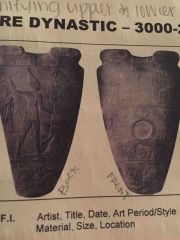
Pre Dynastic |
Palette of King Narmer -how upper and lower Egypt unified -slate stone -function: makeup palette and commemorate his success -form: blueprint for the human canon (the way they depict human body= composite perspective) -papyrus & chair= lower Egypt (sit DOWN) -bowling pin & lotus flower= upper Egypt -upper and lower Egypt didn't like each other and king Namar brought them together -they wore makeup as a spiritual ritual for Raw |
Makeup |
|
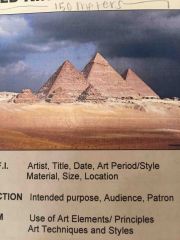
Old Kingdom |
Great pyramids of Giza -kufu (the great pyramid); the largest - kufu is the father of khafre that has sphinx - khafre is father of menkauri who has another pyramid -the moment you become Ohara you plan your funeral -made of granite (core) and limestone (outer) -over 2 million stones - exterior structures: 2 temples, 1 was closer to the river (valley if living; 1st step of mummification) then to casway (hallway) then to mortuary temple (rights and rituals) -grand gallery (stories of pharo) and kings chamber -represented sun rays; raw is always protecting |
3 Pharos 3 pyramids |
|

Old kingdom |
Seated scribe - found in a mastaba (structure) -painted limestone -some association with a Pharos funeral -scribe for pharo in after life -naturalistic= resembles actual person -function: particular person to scribe for pharo in after life -paint comes from ocher and natural colors -informal gesture -over weight =wealth -scribe is a VERY important position |
Writer |
|
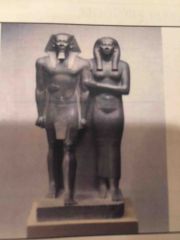
Old kingdom |
Menkauri and queen -made out of Greywack -emphasizes permanence -rigid postures symbolize stability of soul especially in after life -looks very strong and athletic and youthful =idealism -they are connected for eternity -found in mortuary temple in mankaura's burial -serves the kha -taking first step into eternity; left foot is symbolizing stepping with your head dirt into eternity because left foot has vein all the way to heart -breath of life is in them; chests are puffed out |
Ideal |
|
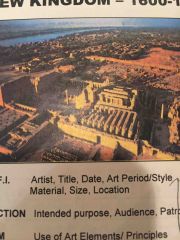
New kingdom |
Temple of Amen-re -found in upper kingdom of Egypt -east side of Niall -pylon shape "M" ; symbolized gateway -entry way to temple -entry way has giant path ways lined with Sphinx -2nd largest religious site in ancient world -very complex and there are several pylon gate ways to prove your worthiness inside temple -giant court that possess stairway if columns; represents phases of life -physical element in architecture represents something spiritual -university for priests and teaches young Pharos how to die -Amen-re sas an early ruler that became God ; king of the gods
Hypostyle hall at Amen-re -130 columns 60 ft tall -multiple Pharos added onto |
|
|

New kingdom |
Tutankhamen's coffin (king tut) -found in upper Egypt in valley of kings -gold, turquoise, lapis lazuli -found in a tomb structure with all of his belongings for the after life -found by Howard carter 1922 - king tut was a king at age 9 and died at 19; insignificant pharo - so extravagant for an insignificant pharo; what would they have done for more important Pharos? -funerary purposes -protected by many layers to protect kha -doesn't matter what pharo you were, alway portrayed and treated like gods |
|
|
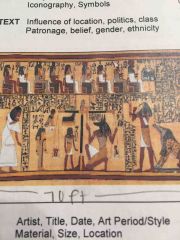
New kingdom |
Book of the dead - found in Thebes (city across from valley of kings) -painted papyrus -function: guide to the after life -hassle lds and curses that people need in after life - old kingdom= walls -Middle Kingdom = coffin -new kingdom = papyrus -applied not just to Pharos but anyone who was wealthy and important enough -composite creatures -judgement of weighing your heart with a feather if heart is heave ur you are eaten by Amit (crocodile composite creature) |
|
|
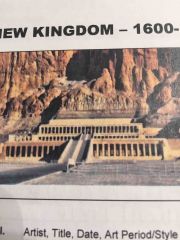
New kingdom f |
Temple of Hatshepsut -near valley of kings -function if temple has changed; not burial necessarily, but a worship site -attached to temple called tut Moses -3 tiered -geometric columns symbolizing light and dark -constant reminder of journey - she loves nature, might have been covered in plants - becomes pharo after husband dies, joint leadership with her son -formal qualities: sentry, repetition of columns -mortuary temple combined with valley temple - she ruled for 20 years -structure would have been painted; very colorful
|
|
|
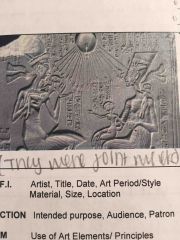
New kingdom- amarna |
Akhenaton and Nefertiti relief -Akhenaton is the pharo that wanted to change art -amarna (upper Egypt) -function: domestic item to remind the people of new religion -lime stone -Akhenaton wanted to distinguish himself from his earlier generations by changing the religion from polytheism to monotheism The new God is Aton -he made it so only him and his aid could worship/ speak to the new God -curvilinear -elongates -more realistic and naturalistic -key figures: Akhenaton and Nefertiti -informa; doesn't looked posed -a renewed focus on life; more focused on this life, not after life - they are playing with their kids -sun rays end in hands except at key figure= breath of life |
|

